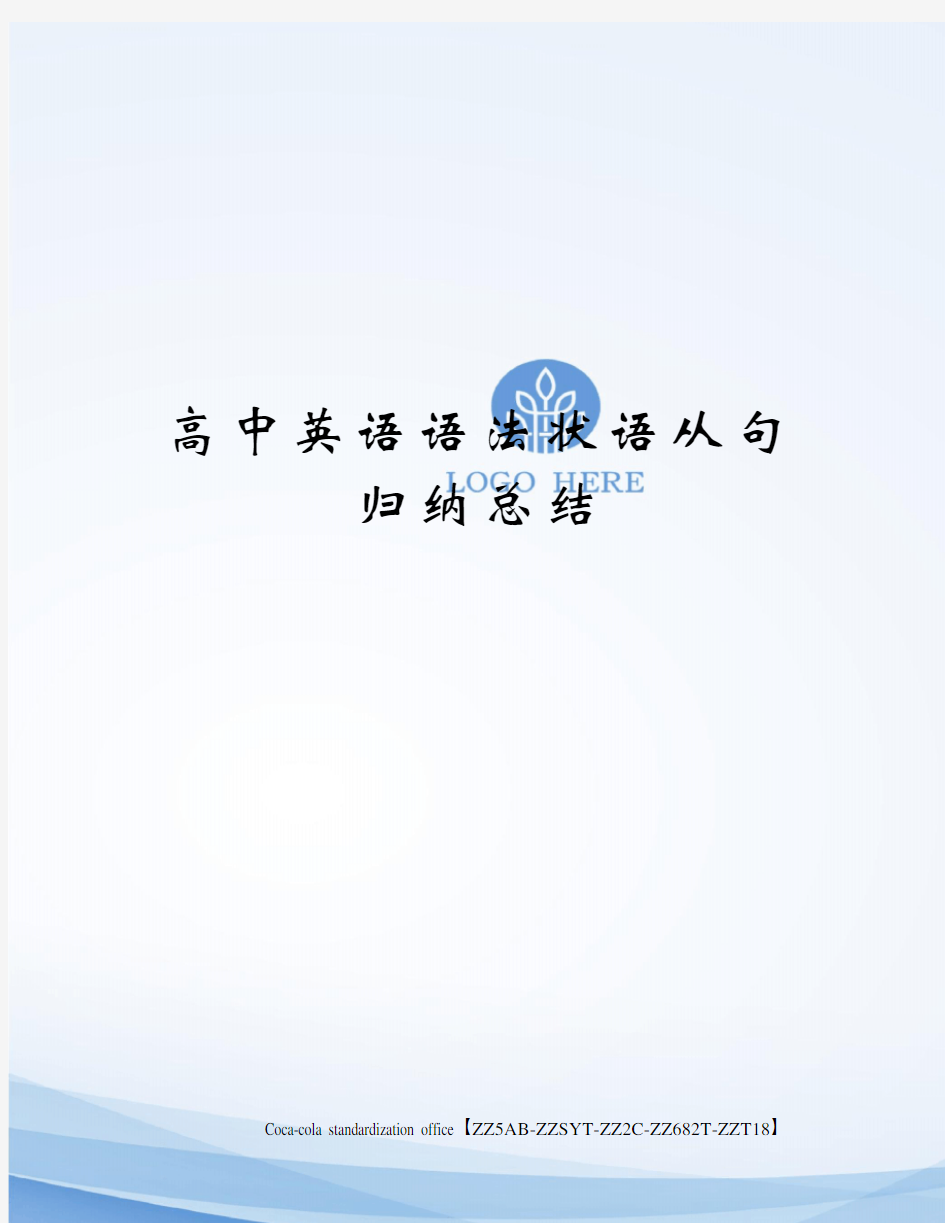高中英语语法状语从句归纳总结


高中英语语法状语从句
归纳总结
Coca-cola standardization office【ZZ5AB-ZZSYT-ZZ2C-ZZ682T-ZZT18】
状语从句一.
二.分类:
such+n.+that(如果……以致) that(所以,因此)
让步状语从句:though/although不可同but连用。
though/although (虽然) however (可是) even though/if(即使)
no matter+what/which/where/who/when
=whatever/whichever/wherever/whoever/whenever
(不论什么/哪一个/哪里/谁/何时)
比较状语从句:as (正如)as…as(和……一样)not as/so … as (不如……)than(比……更)
the+比较级…+the+比较级(越……越……)
条件状语从句:if(假设) unless(如果不) so long as(只要) on condition that (如果)
方式状语从句:as(像……那样地) just as(正像) as if(好像) as though (好像)
三.
四.各种状语从句的简化方法:
1
2.以after和before引导的状语从句的主语若与主句主语一致时,从句等于
after/before+doing sth.作状语。
例:After she sang,she left the rich man's house. = After singing,she left the rich man's house.
3.
4.以as soon as引导的状语从句的主语若与主句主语一致时,从句等于on+doing sth.,作状语,此时的动词为非延续性动词。
例:Mary began to operate on the wounded soldiers as soon as he arrived at the village.
= Mary began to operate on the wounded soldiers on arriving at the village.
5.
6.时间状语从句和条件状语从句的主语和主句主语一致时,有时可简化为不定式作状语。
例:She stopped when she saw her husband. = She stopped to see her husband.
If you want to understand the farmers,you must go to the countryside.
= To understand the farmers,you must go to the countryside.
7.
8.结果状语从句和目的状语从句的主语与主句主语一致时,可以简化为不定式作状语;若两者主语不一致时,则应简化为不定式的复合结构作状语。
例:He was so tired that he couldn't go any further.= He was too tired to go any further.
I came here so that I could ask some questions.= I came here(in order) to ask
some questions.
9.
10.以when,while引导的时间状语从句和以if引导的条件状语从句的主语若与主句主语一致时,从句等于when/while/if +doing sth.作状语,表示谓语动作发生在该状语动作的进行过程之中。
例:When he turned on the radio,he found it broken.= When turning on the radio,he found it broken.
While she was walking along the street,she was hit by a car.= While walking
along the street,she was hit by a car.
11.原因状语从句的主语与主句主语一致时,可简化为分词短语作状语。
例:Since l didn't know Chinese,I tried to speak to her in English.= Not knowing Chinese,I tried to speak to her in English.
注意:形容词短语也可作表示原因的状语,来代替原因状语从句,放在句首、句末均可,但一
般应加逗号。
例:As he was thirsty and eager to get a little rest,he went into the tea-house.
= Thirsty and eager to get a little rest,he went into the tea-house.
12.在时间、原因、条件等状语从句中,若从句和主句主语不一致时,可简化为分词复合结构作状语。有时也可简化为“with/without名词或代词十分词(短语)”形式作状语。
例:When the film start appeared, the children got exited.= The film start
appearing,the children got exited.
If all the work is done, you can have a rest.= With all the work done,you can have a rest.
Nothing can live if there is no air.= Nothing can live without air.
13.让步状语从句的主语与主句主语一致时,可简化为分词短语作状语;不一致时,常简化为with或in spite of介词短语作状语。
例:Although he faced his death,he didn't say anything before the enemy.
= Facing the death,he didn't say anything before the enemy.
Although there was danger,he rushed out to carry the boy to safety.
= In spite of danger,he rushed out to carry the boy to safety.
三.表示"一…就…"的结构
hardly/scarcely…when/before, no sooner…than 和as soon as都可以表示"一…
就…"的意思,例:I had hardly / scarcely got home when it began to rain.
I had no sooner got home than it began to rain.
As soon as I got home, it began to rain.
注意:如果hardly, scarcely 或no sooner置于句首,句子必须用倒装结构:
Hardly / Scarcely had I got home when it began to rain.
No sooner had I got home than it began to rain.
四.As引导的让步状语从句的倒装:
1.形容词+as+主语+系动词:
例:Tired as he is, he offers to help me. 尽管他已经很累了,他还是主动提出帮助我。
2.过去分词+as+主语+系动词:
例:Well-known as the book is, the author is not satisfied and prepared to revise it.
尽管这本书写得很好,作者还是不满意并打算修改它。
3.名词+as+主语+系动词:
例:Student as he is, he does not study hard. 他虽然是个学生,但却不努力学习。4.副词+as+主语+谓语部分:
例:Much as I admire his courage, I don’t think he acted wisely.
我虽然钦佩他的勇气,但我认为他这样做是不明智的。
5.动词原形+as+主语+谓语的剩余部分:
例:Try as you will,you won’t be able to persuade him. 不管你怎么努力,你都说服不了他。
